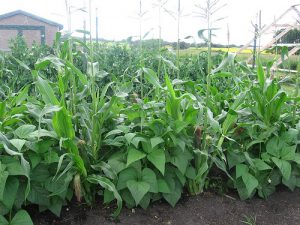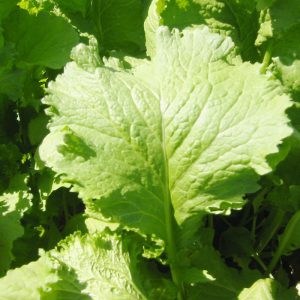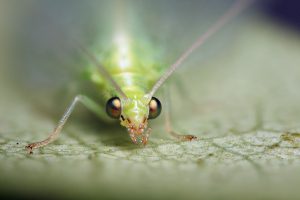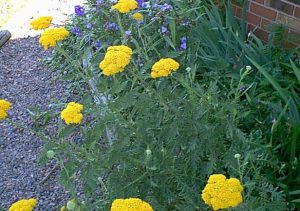Home gardeners that embark on the “organic” journey often find themselves wondering about companion planting. They read about growing organic vegetables, and inevitably come to this subject. Logically, one starts to think, “Is it okay to plant this in my flower bed, or plant some of these next to some of those? Will one or more of the plants interfere or compete with one another? Will one plant provide benefits to the adjacent plants?” Just receiving simple one word answers doesn’t really teach us very much. In this post, I’ll attempt to explain some of the basic science behind companion planting, and the conundrum between plant companions that repel pests and planting those that attract beneficial insects.
Growing two or more different plants in the same garden or container raises a few concerns. Here’s a list of basic topics gardeners need to consider when companion planting. Symbiotic nitrogen fixation, mutual climate co-operation, trap cropping, biochemical pest suppression, the attraction of beneficial insects, and biodiversity. Holy seed starts Batman, that’s a lot to think about! Let’s begin with how these work individually.

Symbiotic Nitrogen Fixation
Plants cannot survive without nitrogen. Unfortunately, plants can’t just breath nitrogen gas which is abundant in our atmoshpere. Instead, microbiological organisms use the ammonia form of nitrogen to manufacture the proteins and other nitrogen-containing nutrients needed to survive. So, what plants can we use to get this task done? Organic gardeners typically use cover crops as companion plants . Peas, beans and other legumes fix atmospheric nitrogen using small growths on their roots called nodules. Those microbes, and the bacteria in your soil, then act as the plant nitrogen broker. Plants ask the microbes for N, the microbes go get it from the nodules and bring it back for the plant in exchange for exudates the plant produces and emits through its roots. Through this symbiotic practice of nitrogen fixation, you will spend less money on nitrogen fertilizer.
Mutual Climate Co-operation
Mutual climate co-operation refers to planting crops that, when they become full size, complement the needs of plants growing around them. A good example of this is planting tall, sun-loving plants like corn, alongside short, shade-tolerant plants, like beans, that will lend a helping hand to the corn. These combinations will help both plant types produce better yields, and provide more pest control benefits overall. Another superior companion plant is Marigolds. Marigold is a sun lover but will enjoy the shade provided by other garden plants as they get older. Dappled sunlight will extend your Marigold’s flowering cycle. The scent and exudates of those flowers is what keeps bugs away from your eggplants or peppers. A little more on Marigolds later.

Trap Cropping
Trap cropping refers to the planting of a specific plant. It’s a decoy plant. The goal is to attract pests away from your feature crop . What I call ‘Double Trap’ crops, are those that attract bugs away, plus prevent those bugs from reproducing. For example, Southern Giant Curled Mustard, when planted around a garden perimeter, makes for an effective trap crop in controlling pierce-sucking insects that feed on the leaves. These insects generally leave blotches and holes in leaves. Sound familiar? The mustard plant gets male insects to release pheromones which attract other like kind bugs. In addition, this mustard produces a type of enzyme called homing endonuclease, that can render pierce suckers sterile.
Biochemical Pest Suppression
Some plants exude chemicals that can protect neighboring plants. For example, marigolds release thiopene, an aerial pest suppression that helps to repel many insects and nematodes. Nasturtiums have been shown to have larvacidal effects on leafminers. In addition, some plants emit pheromones that confuse male insects, causing them not to mate. Another form of biochemical suppression is a phenomenon called allelopathy. Allelopathy is the release of chemicals from the root system to discourage insects. Voodoo Lily can produce allelopathic chemicals that deter fungus gnats. These chemicals can have a positive or negative influence on surrounding plants. Those that have a negative influence can be an important part of another plants’ defense, reproduction and growth systems.

Attracting Beneficial Insects
Planting neighboring plants to attract good bugs is traced all the way back to ancient Egypt. This strategy is used when the main plant lacks the ability to attract the good guys on its own. To determine what type of beneficial insects you want to attract, get an idea of what pest insects you are likely to encounter. My personal favorite to attract and keep around is the green lacewing. The lacewing larvae resembles an alligator and they attack and eat everything you want them to. There is a long list of good predators and an equally long list of plants they are attracted to. I promise you’ll always find fern yarrow, dill, coriander (cilantro), and mint planted around my garden. There is a subtle balance however, between the number of companions that are repellants and those that are beneficial attractants. This leads us right into biodiversity.
Biodiversity
Many insects and disease organisms prefer specific plant species. For example, horn worms love tomatoes so much that they are commonly called tomato worms. Cabbage loopers love to chow down on not only cabbage, but also broccoli, brussel sprouts, cauliflower, collards, and kale. Now think about how the hornworm views a monocrop field of tomatoes, or looper moths see a monocropping of any of the vegetables mentioned. It’s an all you can eat buffet with 100% of your absolute favorite foods. It is imperative to mix up not only your crop types, but also your repellants and attractors. You reduce the likelihood of a massive infestation by creating a balance of plants that will keep the bad guys away and keep the good guys around.

Let me give you a specific example that you can put to use right away. This example targets all too common garden pests, like spider mites. I prefer to use repellant plants you can eat. Aditionally, consider at least 4 attractants. As an example, I enjoy eating coriander (cilantro), thyme, fennel and dill which are both repellants and attractants. Then I mix in angelica, tansy, chrysanthemums, marigolds and fern yarrow here and there around the garden.
I’m barely scratching the surface of this subject. To learn more about Organic Gardenng, this EDIS link is a good place to begin:
http://edis.ifas.ufl.edu/topic_organic_gardening
References:
- Mayer, Daniel (2010) “The complete guide to companion planting. Everything you need to know to make your garden successful”. Atlantic Publishing Group ISBN-10: 16202300382.
- Landon, Amanda J. (2008). “The “How” of the Three Sisters: The Origins of Agriculture in Mesoamerica and the Human Niche”. Nebraska Anthropologist. Lincoln, NE: University of Nebraska-Lincoln: 110–124.
- Pleasant, J. (2006). “The science behind the Three Sisters mound system: An agronomic assessment of an indigenous agricultural system in the northeast”. In Staller, J. E.; et al. Histories of maize: Multidisciplinary approaches to the prehistory, linguistics, biogeography, domestication, and evolution of maize. Amsterdam. pp. 529–537
- Holden, Matthew H.; Ellner, Stephen P.; Lee, Doo-Hyung; Nyrop, Jan P.; Sanderson, John P. (2012). “Designing an effective trap cropping strategy: the effects of attraction, retention and plant spatial distribution”. Journal of Applied Ecology. 49 (3): 715–722. doi:10.1111/j.1365-2664.2012.02137.x. ISSN 1365-2664
- “Pacific Northwest Nursery IPM. Flowers, Sweets and a Nice Place to Stay: Courting Beneficials to Your Nursery”. Oregon State University. February 2013
- Dan Pearlman, Glenn Adelson, (1997) “Biodiversity exploring values and priorities in conservation” Blackwell Science Press
- Horticulture Research International, Wellesbourne : “Insects can see clearly now the weeds have gone”. Finch, S. & Collier, R. H. (2003). Biologist, 50 (3), 132-135
- “The Self-Sufficient Gardener Podcast–Episode 24 Companion Planting and Crop Rotation”.2010.
- Pleasant, Barbara (June–July 2011). “Organic pest control what works, what doesn’t”. Mother Earth News (246): 36-41.
 0
0

Comments:
October 18, 2021
Hi Lane, I attached some information via email. Thanks
October 17, 2021
I think I know the answer to this but can you confirm that growing crops in a hydroponic system can not be sold, even at a farmers market, unless that land is categorized as agricultural or if you fall into the "limited use" category, which I believe that requires atleast a single acre of land? If this is correct, do you know if there is any exemptions, as my property would not qualify for limited use, as it's only a half acre. I'm just trying to sell my produce at farms markets as a side business! Thanks for any advice, feedback you can give.
March 30, 2021
You certainly can try to sprout them. You will have a far far greater germination rate if you cold stratify the seed first. Its a very simple process that just requires a wee bit of patience.
March 29, 2021
I’m curious about the cold germination. I’m in zone 10 and the pods are opening. Do I need to do this cold germination process or can I just try to sprout them? Thank you.
March 24, 2021
You are right, good catch! Many of the gardens during the Renaissance Period had varying underlying principles/theories. Le Notre definitely created the synthesized definition of French Classical Gardens, starting with Vaux-le-Vicomte, which definitely had Renaissance/Baroque garden influences. One major difference I've always liked was the use of theatrical perspectives within gardens (focal points, unification around one plane/frame, and use of planes to influence depth) and Mollet's influence on parterres. Of course, the French-style gardens were substantially more grandiose than the Italian Renaissance for purposes of pleasure, entertainment, conducting court, etc, but focused much on absolutism. I'd love for you to send me some additional resources because it is hard to find them. You can send me a direct email to taylorclem87@ufl.edu Thank you.
March 23, 2021
The Gardens of the Palace of Versailles is not a Renaissance Garden. It is instead a French Classical Garden, which held quite strongly opposing values of the renaissance ideals. It was not even in close proximity with the Renaissance period.
January 12, 2021
Thank you for your great question. We have lots of materials and resources available online for homeowners. The Gardening Solutions webpage is a great webpage for all homeowners (www.gardeningsolutions.ifas.ufl.edu). We also have a county webpage dedicated to the Florida-Friendly Landscaping Program that includes additional resources (https://sites.google.com/ufl.edu/alachuaffl/home). Regarding services, we offer programs throughout the year relating to landscaping best management decisions and vegetable gardening. I recommend checking out our county’s programs/events page for all our upcoming programs (https://sfyl.ifas.ufl.edu/events/?location=alachua). Other services we provide include our Master Gardener Volunteer Help Desk. You can reach out to our Master Gardeners Volunteers via email (mag@alachuacounty.us)or phone (352)955-2402 to help troubleshoot any issues within your landscape or garden. Also, the Master Gardeners perform Florida-Friendly Landscape Recognitions. Volunteers visit a homeowner’s property and do a landscape evaluation. This free evaluation allows homeowners to learn ways to improve their landscapes and potentially earn a Gold or Silver landscape recognition. Taylor Clem, PhD Environmental Horticulture Extension Agent UF/IFAS Alachua County Extension 106 SW 140th Terr. Suite 3 • Newberry • FL • 32669 955-2402 (office)
January 8, 2021
Is there any documentation, preferably online, that defines and lists the availability of services for homeowners and those planning on planting beneficial plants on their property?
October 6, 2020
I recommend reaching out to our office. Dr. Cindy Sanders is our county's livestock agent and she will be able to answer your question and give recommendations. Feel free to call us from (352)955-2402
August 23, 2020
I would like to know if horses can Eat sunshine mimosa
August 3, 2020
Great Blog! Looking forward to more!
July 9, 2020
Genevieve, Thank you for reaching out. We have quite a few publications that can help you out! Here are a couple articles from UF/IFAS Extension relating to butterfly gardening and attracting wildlife to your landscape. If you'd like further information, feel free to reach out to our office at (352)955-2402 or email our Master Gardener Volunteer help desk at mag@alachuacounty.us. Butterfly Gardening in Florida: https://edis.ifas.ufl.edu/pdffiles/UW/UW05700.pdf Landscape Backyards for Wildlife: https://edis.ifas.ufl.edu/pdffiles/UW/UW17500.pdf
June 19, 2020
Interested in plants that are easy, come up each year. attract butterflies and humming birds
May 27, 2020
Good morning, Thank you for reaching out to UF/IFAS Extension Alachua County. I'll forward your question to our Livestock Agent, Dr. Cindy Sanders. She'll be able to give you the best recommendations regarding your pasture. Thank you, Taylor Clem
May 26, 2020
I'm in Alachua county and over the years Sunshine Mimosa has spread across quite a bit of my bahia grass horse pasture. It's intermixed with the grass. I'm not finding anything that says it's toxic to horses but I don't think my horses eat it. I think I could control it with herbicide but am hesitant because it is always covered with honey bees and native bees. Is this something I should try to control? Is there a danger that it will choke out my pasture?
April 27, 2020
Monarchs caterpillars only eat milkweed, and the butterflies only lay eggs on milkweed.
April 23, 2020
I have counted as many as 30 monarch (and queen) caterpillars munching happily on my Giant Milkweed. Later I discovered more than 15 spent chrysalis in the cat palm growing beside it.
April 20, 2020
Hi Carlos, I recommend always to follow science-based information, shadow a beekeeper and have the opportunity to learn some about the biology and principles of honeybees before any major investment. Keep in mind that keeping bees in Florida is different from keeping bees in other areas so try to learn from resources that are focused at least to the South East. The beekeeping series offered in Alachua County is a good place to start, the next series cycle starts in November. I also recommend Bee College and the Master Beekeeping program at UF. You can do it online or face-to-face (annual event). You can check it out at http://entnemdept.ufl.edu/honey-bee/extension/master-beekeeper-program/. If you have specific questions on these programs you may contact Amy Vu at amy.vu@ufl.edu. Lastly, you can contact the Gainesville Area Bee Club and join them to meet other beekeepers and learn about others' experiences (https://www.gainesvilleareabeeclub.com/). Here are some recommended sources for you to start exploring beekeeping: - http://entnemdept.ufl.edu/honey-bee/beekeeper-resources/ - https://impact.extension.org/?s=beekeeping - https://honeybeehealthcoalition.org/
April 18, 2020
Hello I would like to start with bee keeping!! Any advise ?
April 16, 2020
Hello do Monarch caterpillars eat only milkweeds leave or will they ravage my entire garden?
April 14, 2020
James, There are different types of turfgrass species, but finding a specific species that are good for sun and shade is difficult. Seville St Augustine and Empire Zoysiagrass are the most shade-tolerant turfgrasses, but they still need a good amount of sun. Areas directly under trees won't typically develop a good turf stand. The best strategy for managing turfgrass is following IFAS recommendations for growing turf in shadier conditions. If you would like to get more information, email me at taylorclem87@ufl.edu. Also, we have an upcoming webinar on turfgrass management on April 23 from 4 - 5:30pm. You can register and see more information here: https://www.eventbrite.com/e/turfgrass-in-alachua-county-tickets-102293845646 Thank you very much, Taylor Clem Environmental & Community Horticulture Agent UF/IFAS Extension Alachua County.
April 6, 2020
I am looking for a grass to replace my St. Augustine which has been eaten by chinch bugs. I have both full sun and full shade areas. My yard is now almost completely covered by sand burs. Is there one grass for both shade and sun? I am a disabled vet and mowing the grass is about the limit of the yard work I can do.
March 17, 2020
I'm guessing the March 19 event is cancelled. However, if you had handouts about planting edible plants, would you either post them or email them to me? Thanks!
February 4, 2020
Thank you so much for your article. I am a firm believer in Companion planting.
June 5, 2019
I recently purchased a giant milkweed plant. I had never heard of it before. Do monarch caterpillars like it as much as regular milkweed? Thanks!
July 11, 2018
Dam awesome Kevin. I'm proud of you!
June 12, 2018
Hi Dave - I would, as carefully as possible, transplant. Ideally you would want to wait until your plants are roughly 3 inches tall. You may still want to wait with 1/2 of your plants. I just don't know if your plants will make that size given you germinated in egg cartons. You could also cut the egg cartons apart & just transplant the whole thing. The egg cartons should decompose. Good Luck.
June 12, 2018
I have planted 6 varieties of .milkweed from seeds in paper egg cartons after 30 days in the fridge. Germination went well. I have about 20 young seedlings about 3/4 to an inch high. Should I get them out of the cartons and into pots now or wait til they're bigger? Thanks
June 1, 2018
Santa Rosa Gardens, a mail-order company in Pensacola, Florida has incarnata and tuberosa. The website is santarosagardens.com. Tell them Louise from the Panhandle Butterfly House sent you. They are a great company.
Comments are closed.